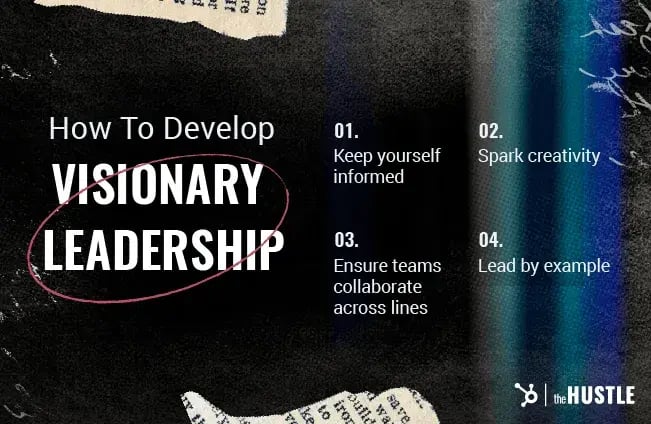To lead an organization, you need a powerful vision of the future. Entrepreneurs must adopt a compelling leadership style to drive their company toward this common objective. Visionary leadership, a style of leadership focused on a strong organizational vision, can push your organization and leadership to the next level.
Adopting a strong leadership style matters for your company’s success. Fewer than five in 10 employees regard their company’s leadership as “high quality.” Meanwhile, research indicates 70% of leadership comes from learning, not genetics, meaning anyone has the ability to develop as a strong visionary leader.
Table of contents:
- What is visionary leadership?
- Visionary leadership style
- Visionary leadership examples
- How to develop visionary leadership
What is visionary leadership?
%20(1).png?width=650&height=250&name=Minimum%20Viable%20Product%20new%20products%20that%20allow%20teams%20to%20capture%20the%20maximum%20amount%20of%20customer%20data%20using%20the%20least%20amount%20of%20effort.%20(14)%20(1).png)
Visionary leadership is a type of leadership that guides and inspires teams toward a future vision. Visionary leadership entails:
- Setting a clear and impactful vision
- Communicating that vision throughout the organization
- Pursuing new opportunities
- Embracing risk and change
- Inspiring others to pursue a common goal
Visionary leadership imbues benefits into your organization, such as:
Higher motivation: A clear, exciting vision motivates employees to help the organization achieve it
Greater innovation: Visionary leadership embraces change and risk-taking, increasing your organization’s culture of innovation
Better employees: Visionary leaders create inspiring visions for their organization, which helps attract and keep top talent
Speeds up decision-making: Having an organization’s eyes on one solid goal speeds up decision-making — as everything should point to seeing that vision through
Builds resilience: A clear vision means a clear path for the organization to follow, enabling it to jump over unexpected obstacles
Visionary leadership style
1. Future-oriented
Visionary leaders keep their eyes on the future. The vision they select for their organization occurs in an indefinite place in the future. It might mean creating the top-selling product in a certain industry, or reaching a certain number of customers.
Regardless, visionary leaders keep their focus on the future and make continuous improvements to get there.
2. Innovative
In-demand employees often join companies with innovative cultures, which visionary leadership helps cultivate. A visionary leader maintains an open mind, embraces change, and welcomes ideas.
Since their vision usually entails growth, they recognize the necessity of innovation to scale. This means seeking ways to innovate products, challenging processes to make them more efficient, and looking for ways to add more value.
3. Inspirational
68% of people want brands to inspire them more — which visionary leadership aims to achieve. Using their clear goals, visionary leaders motivate and empower teams. They communicate impactfully, lead the way through their actions, and create a vision that the entire organization can participate in.
4. Risk-positive
Businesses cannot avoid risk; visionary leaders embrace it. They value taking calculated risks and big swings. Because of their preference for innovation, they recognize the necessity of dealing with risk and uncertainties. When failures do happen, they embrace them as learning opportunities.
5. Passionate
One research study found a direct correlation between a leader’s passion and their workers’. Visionary leaders exhibit passion in their leadership style. They believe in their vision and strive to inspire others in their organization. Their passion fosters commitment among other employees, helping the company align on reaching objectives.
6. Empathetic
Through a survey, EY found that empathy shared between employees and leaders increases efficiency, creativity, job satisfaction, idea sharing, innovation, and company revenue by more than 80%. Visionary leaders show high levels of empathy and strive to listen to their employees’ ideas, wants, and feedback.
7. Decisive
Driven by a clear vision, visionary leaders make decisions efficiently. They take stock of the information available to them (such as data), consider different routes, and make decisions. They often ask for others’ perspectives, but always end up making decisive choices.
8. Adaptable
Visionary leaders recognize the volatility that comes with embracing a long-term goal. Their leadership reflects this reality, as they succeed in dynamic and fast-changing environments. They keep themselves and their organization flexible, whether that means changing old ways of doing things or incorporating new processes.
9. Collaborative
Visionary leaders acknowledge the necessity of collaboration in achieving a vision. They regularly ask for input from others, regardless of their position in the organization, and view their vision as a shared one.
10. Growth-oriented
To achieve their goals, visionary leaders strive to grow themselves. They continuously improve themselves, such as by learning new skills. Not only that, but they view hurdles and failures as opportunities to grow and learn.
11. Bold
Visionary leaders take bold steps. The foundation of their vision often involves creating impact, one that can excite an entire organization. Part of innovating, growing, and inspiring means making big moves — a core part of visionary leadership.
12. Emotionally intelligent
Studies demonstrate that emotional intelligence, or the ability to recognize and evaluate your own emotions, matters more for success than cognitive ability. Visionary leaders espouse emotional intelligence by recognizing their feelings and learning to understand others’ emotions. They create supportive, open, and caring work environments and relationships.
13. Articulate
To create a compelling vision, visionary leaders articulate and communicate clearly. They know how to express themselves and their goals, enabling them to get other employees onboard with their ideas and plans.
Visionary leadership examples

Visionary leadership means demonstrating some or all of the traits listed above.
Consider a CEO who wants to stay adaptable as artificial intelligence shakes industries up. To do so, they host brainstorming sessions with different teams on how their business can integrate the technology. They incorporate this information and create an impactful vision of growing their business with AI. They also communicate this vision clearly via email and in person, taking feedback from others on how to best convey their future goals.
Alternatively, a visionary leader can lead by example. Say a hypothetical business leader regularly takes risks themselves and, when they fail, they acknowledge their failures and extract value from these experiences. They publicize them to the organization with transparency, which encourages others to follow along.
How to develop visionary leadership
Keep yourself informed
If you want to cultivate visionary leadership, you need to keep a pulse on aspects of the future. You can do this by staying up to date with industry trends by reading magazines, conducting regular customer research, and completing other tasks.
Spark creativity
To build innovation, a key component of visionary leadership, host activities that help cultivate it, such as brainstorming sessions, workshops, and other group activities.
Ensure teams collaborate across lines
To foster collaboration, you need to create opportunities for yourself and others to collaborate outside their department. Involve different teams on projects. Ask for a diverse array of opinions. Create space for knowledge sharing, such as a company-run wikipedia.
Lead by example
You should model the behavior you want your organization to follow. Practice values of visionary leadership by:
- Displaying your passion for the organization’s vision
- Holding yourself accountable when making mistakes
- Showing your commitment to the organization by working hard
What did you think of this article?
Leadership

%20(1).png)
.png?width=651&height=424&name=Visionary%20Leadership_72-01%20(1).png)





.png)
%20(1).png)
.png)
%20(1).png)




%20(1).png)